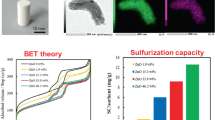Abstract
A porous silicate material derived from silica fume was successfully prepared and characterized by X-ray diffraction (XRD), X-ray photoelectron spectroscopy (XPS), Fourier-transform infrared (FT-IR) spectroscopy, Thermogravimetry and Differential thermal gravity (TG-DTG), N2 adsorption and desorption isotherms, and scanning electron microscopy (SEM). Raw silica fume was analyzed by XRD, FT-IR and SEM. The analysis results of silica fume indicated that SiO2 in silica fume is mainly determined as amorphous state, and that the particles of raw silica fume exhibited characteristic spherical structure with a diameter of from 50 nm to 200 nm. The preparation of the porous silicate material involved two steps. The first step was the extraction of the SiO 2−3 leachate from raw silica fume. The maximum value of SiO 2−3 extraction yield was obtained under the following conditions: reaction temperature of 120 °C, reaction time of 120 min, NaOH concentration of 15%, and alkali to SiO2 molar ratio of 2. The second step was the preparation of the porous silicate material though the reaction of SiO 2−3 leachate and Ca(OH)2 suspension liquid. The optimum preparation conditions were as follows: preparation temperature of 90 °C, preparation time of 1.5 h, Si/Ca molar ratio of 1 : 1, and stirring rate of 100 r/min. The BET surface area and pore size of the porous silicate material were 220.7 m2·g−1 and 8.55 cm3/g, respectively. The porous silicate material presented an amorphous and unordered structure. The spectroscopic results indicated that the porous silicate material was mainly composed of Si, Ca, O, C, and Na, in the form of Ca2+, SiO 2−3 , CO 2−3 and Na+ ions, respectively, which agreed with the XRD, TG-DSC, and FT-IR data. The N2 adsorption-desorption isotherm mode indicates that the porous silicate material belonged to a typical mesoporous material. The porous silicate material presented efficiency for the removal of formaldehyde: it showed a formaldehyde adsorption capacity of 8.01 mg/g for 140 min at 25 °C.
Similar content being viewed by others
References
X. Li, A. H. Korayem, C. Li, Y. Liu, H. He, J. G. Sanjayan and W. H. Duan, Constr Build Mater., 123 (2016).
Z. Jinliang, G. Zhancheng, Z. Xin and T. Huiqing, Chin. J. Pro. Eng., 12 (2012).
C. Zhou, C. Yan, J. Zhao, H. Wang, Q. Zhou and W. Luo, J. Taiwan. Inst. Chem. E, 62 (2016).
H. Ji, Z. Huang, K. Chen, W. Li, Y. Gao, M. Fang, Y. Liu and X. Wu, Powder. Technol., 252 (2014).
M. Mastali and A. Dalvand, Constr. Build. Mater., 125 (2016).
M. Fakhri and F. Saberi. K, J. Clean. Prod., 129 (2016).
A. A. Ramezanianpour, Springer Berlin Heidelberg, 193 (2014).
L. Lijuan, L. Tielong and J. Zhaohui, Chin. J. Enviro. Eng., 4 (2010).
V. Lilkov, O. Petrov, D. Kovacheva, I. Rostovsky, Y. Tzvetanova, V. Petkova and N. Petrova, Constr. Build. Mater., 124 (2016).
F. N. Okoye, J. Durgaprasad and N. B. Singh, Ceram. Int., 42 (2016).
H. Gaoping and X. Weidong, Henan. Chem. Ind., 07 (2006).
Z. Deyi, F. Huixia, L. Heming, W. Yi, C. Xuefu and W. Yanjun, Chin. Non-Metallic. Miner. Ind., 5 (2009).
W. Li, X. Ping, Y. Xu, H. Li, Z. Yi and Y. Tang, Concrete., 6 (2011).
H. Zhu, Shandong University of Science and Technology Doctor Degree (2009).
H, Hai, Y. Zhang, Y. Zhang, J. Sun and Z. Hao, Chin. J. Enviro. Eng., 11 (2017).
16. J. Zhang, Z. Guo, X. Z and H. T, Chinese J. Environ. Eng., 12, 2 (2012).
Azouaoua N, Sadaou Z, Djaafri A, et al., J. Hazar. Mater., 184 (2010).
Anirudhan T S, RadhakrishLnan P G, Thermodynamics., 40 (2008).
I. Langmuir, J. Am. Chem. Soc., 40, 1361 (1918).
S. Onisei, Y. Pontikes, T.V. Gerven, G. N. Angelopoulos, T. Velea, V. Predica and P. Moldovan, J. Hazard. Mater., 101 (2012).
Y. Gao, H. Huang, W. Tang, X. Liu, X. Yang and J. Zhang, Micropor. Mesopor. Mater., 217 (2015).
G. J. Maximo, A. J. A. Meirelles and E. A. C. Batista, Fluid Phase Equilibr., 299 (2010).
R. Wang, Y. Zhai, Z. Ning and P. Ma, T Nonferr Metal Soc., 24 (2014).
R.R. Yadav, S.N. Mudliar, A.Y. Shekh, A.B. Fulke, S.S. Devi, K. Krishnamurthi, A. Juwarkar and T. Chakrabarti, Process Biochem., 47 (2012).
J. Sun, Z. Wu, H. Cheng, Z. Zhang and R. L. Frost, Spectro. Act. Part A: Mole. and Biomo. Spec., 117 (2014).
X. Yang, X. Liu, W. Tang, Y. Gao, H. Ni and J. Zhang, Korean J. Chem. Eng., 34, 3 (2017).
L. Li, Y. Zhang, Y. Zhang, J. Sun and Z. Hao, J. Therm. Anal. Calorim. (2016), DOI:10.1007/s10973-016-5711-4.
H. Zaitan, D. Bianchi, O. Achak and T. Chafik, J. Hazard. Mater., 153 (2008).
A. Meiszterics, L. Rosta, H. Peterlik, J. Rohonczy, S. Kubuki, P. Henits and K. Sinko, J. Phys. Chem. A, 114 (2010).
Y. Zhang, Q. Liu, Z. Wu, Q. Zheng and H. Cheng, J. Therm. Anal. Calorim. (2012), DOI:10.1007/s10973-011-2038-z.
Y. Zhang, Q. Liu, Z. Wu and Y. Zhang, J. Therm. Anal. Calorim. (2015), DOI:10.1007/s10973-015-4652-7.
P. Xiaoqin, Z. Huixing, J. Xiaohua and X. Guowei, J. Chin. Cer. Soc., 36 (2008).
P. Xiaoqin, H. Fang, Z. Le, Qi. Xuejun and T. Yuanyan, J. Southwest Jiaotong Univ., 44 (2009).
H. Jilin, L. Xin, X. Hanning, Y. Zhishu and P. Yangxi, Inorgan Chem. Ind., 41 (2009).
H. Jingnan, S. Junmin, X. Xuebin, Y. Huibin and L. Yungai, Bulle. Chin. Cer. Soc., 35 (2016).
W. Tang, H. Huang, Y. Gao, X. Liu, X. Yang, H. Ni and J. Zhang, Mater. Des., 88 (2015).
B. Özkaya, J. Hazard. Mater., B 129, 158 (2006).
Author information
Authors and Affiliations
Corresponding author
Rights and permissions
About this article
Cite this article
Zhang, Y., Qi, H., Li, Y. et al. Preparation and characterization of a porous silicate material from silica fume. Korean J. Chem. Eng. 34, 3185–3194 (2017). https://doi.org/10.1007/s11814-017-0228-5
Received:
Accepted:
Published:
Issue Date:
DOI: https://doi.org/10.1007/s11814-017-0228-5



